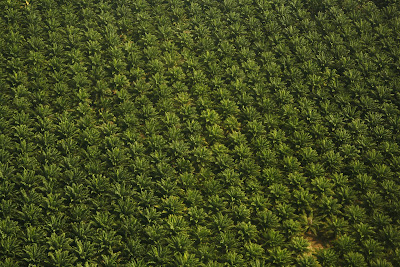Palming off the true cost of Palm Oil
"...biodiversity loss in one of the world's most biodiverse regions; land degradation...loss of ecosystem services;...release in the atmosphere of large quantities of carbon...". These are just some of the so-called externalities excluded from the balance sheet of most corporations producing Palm Oil, says Pavan Sukhdev. The result, he says, is that the economics of of palm oil, Alice in Wonderland fashion, get "curiouser and curiouser".
A few weeks ago I was lucky enough to be invited along (by Hugh Pritchard) to a talk at London's Reform Club. A formal affair - black tie, mobile phone use banned, and dinner begun with the sound of a gavel striking the dining table - but delightfully British and indeed delightful but challenging.
The speaker was Pavan Sukhdev, an economist with a heart, and a green one at that. He took time off from working with Deutsche Bank to write a number of influential documents on the green economy, in particular the Economics of Ecosystems and Biodiversity (TEEB) report.
I bought his latest book Corporation 2020 from him on the way out and have just started to read it. He inscribed it "To Tim, Hope to meet you in Australia - the land of 'Resource Tax' allergy - I hope we can bring some sense to this space. Enjoy the book! Pavan" (I sat next to him during the dinner and our main topic of conversation was the Resource Tax in Australia and how important it was to balancing the accounts...but more about that later, when I finish the book perhaps).
For today I wanted to focus on his analysis of Palm Oil production and how the books are far from balanced on this destructive crop. It's a familiar story, but worth repeating. Botanic gardens started it all of course. It was British colonial traders, presumably with material accessed from Kew Gardens, that planted African Oil Palm (Elaeis guineensis) in the botanic gardens of Java, Kebun Raya Bogor.
Once it was obvious how well it suited the local climate, African Oil Palms plantations spread throughout South-east Asia. According to the Kew website, it is now the highest yielding of all the tropical oil-producing plants. Palm Oil comes from the flesh of its fruits and Palm Kernel Oil from its seed. You can find the former in margarine, ice-cream, soap, right through to nepalm!
Indonesia is now the world's top producer, with 5 million hectares under cultivation in 2010 - up from 3 million hectares in 2000 and a mere 200,000 in 1967. Most of the new plantations, according to Sukhdev, have replaced rainforest growing on peat bogs. The result, I have summarised at the top of this post.
Sukhdev says that none of these costs have been taken into account when decided whether to remove the natural rainforest. Gains from timber concessions are in the accounts but this is where it gets into Alice in Wonderland territory. Sukhdev compares this kind of economics to 'claiming that someone makes so much money selling hats, that their shoe business is profitable'.
The result of these kind of sums is that continued logging is required for palm oil to remain profitable.It doesn't make long-term economic sense as it stands, let alone take into account the real (environmental) cost of destroying rainforests, says Sukhdev.
Pavan Sukhdev continues, pointing out that Indonesia is the world's third largest greenhouse-gas emitter, 80% from deforestation and destruction of peat. He notes that lots of charismatic mammals are limited to this region and are now listed as endangered or critically endangered.
There are some companies sourcing their oil from sustainable plantations, although it's difficult to substantiate in most cases. In general, though, we eat, wash and kill with palm oil, undeterred by the consequences...and the cost.
Images: The aerial shot of palm oil plantations is from Greenfieldgeography; the destroyed forest picture from WWF, and the palm oil in a bottle from Wikipedia.




Comments